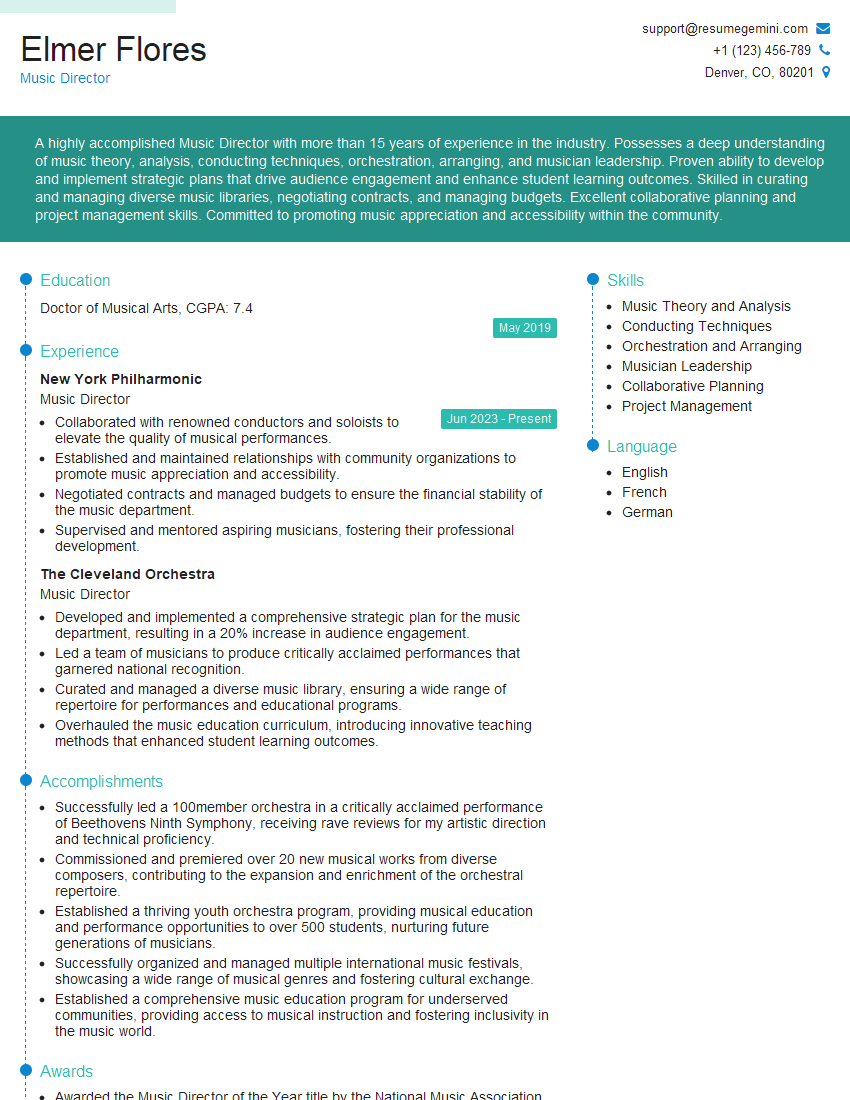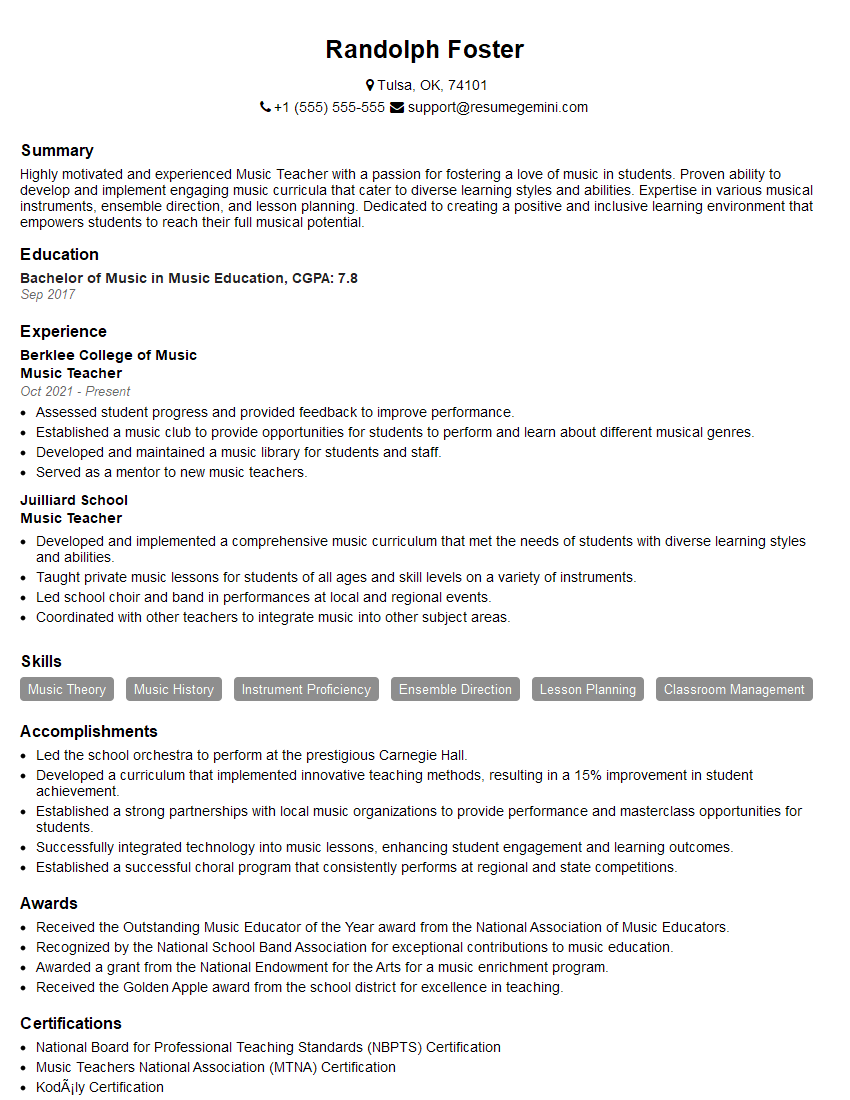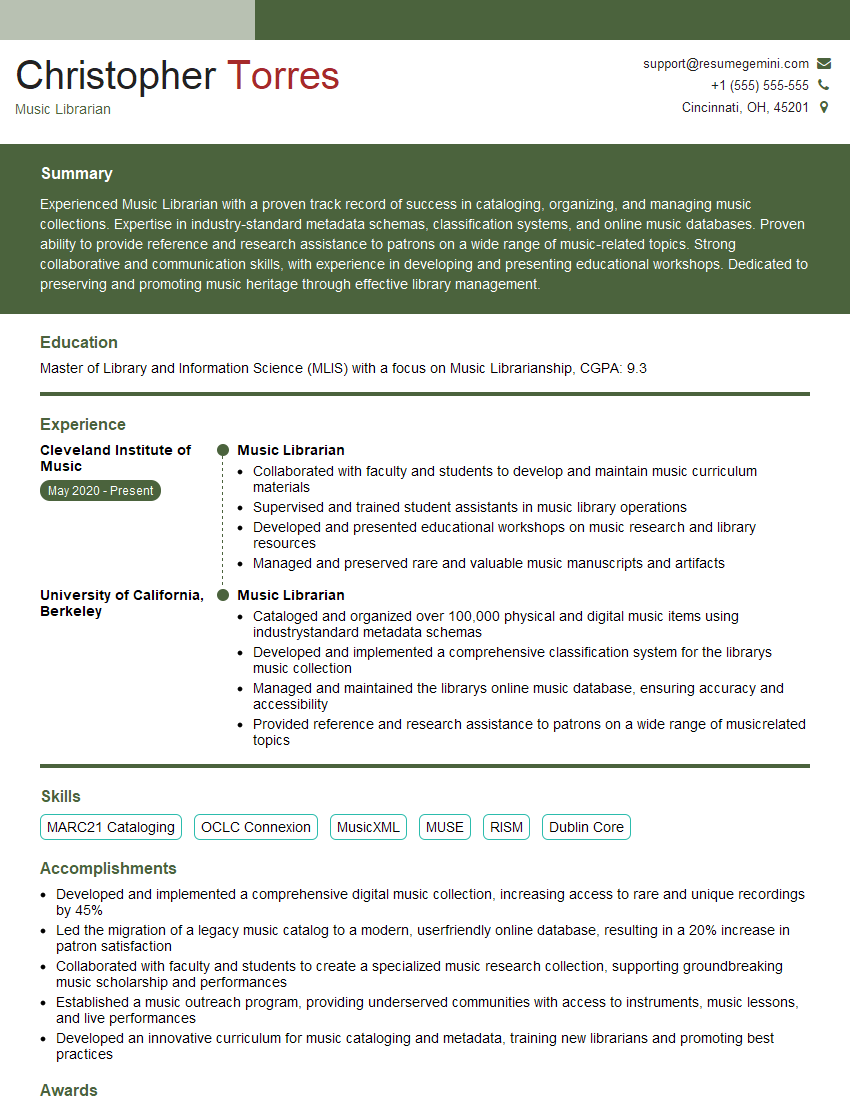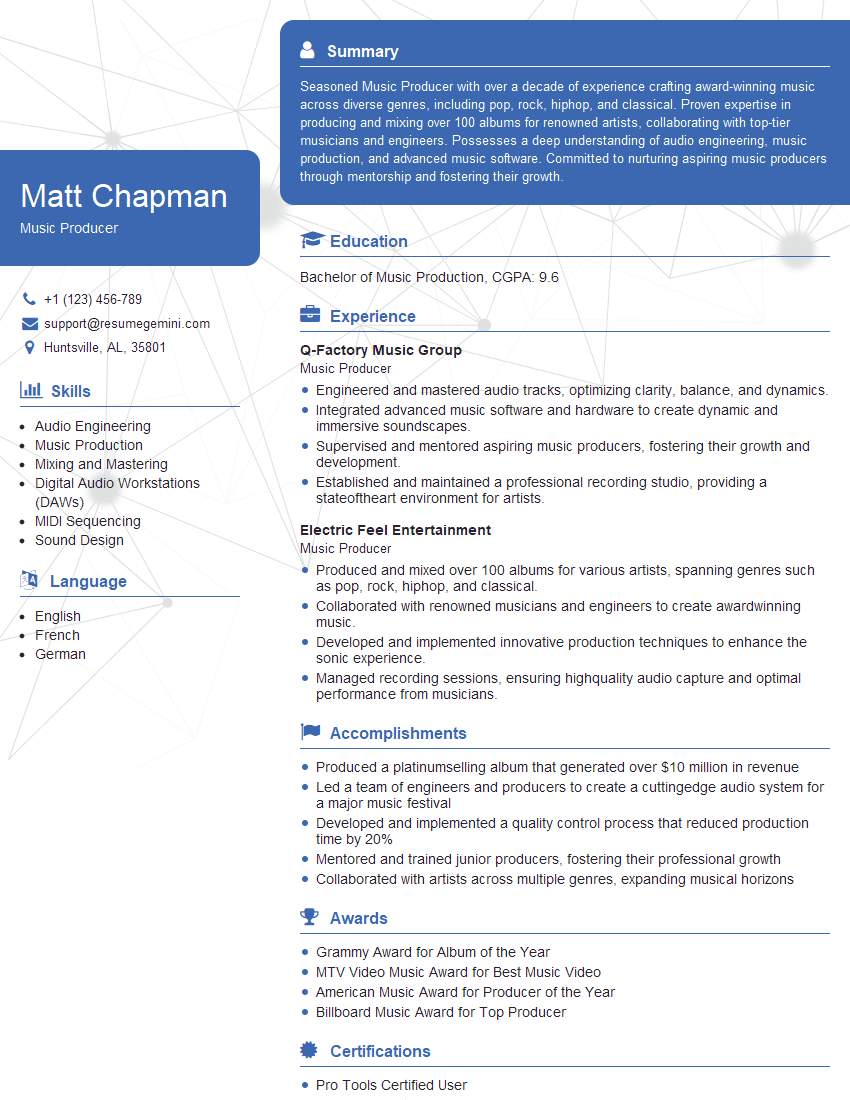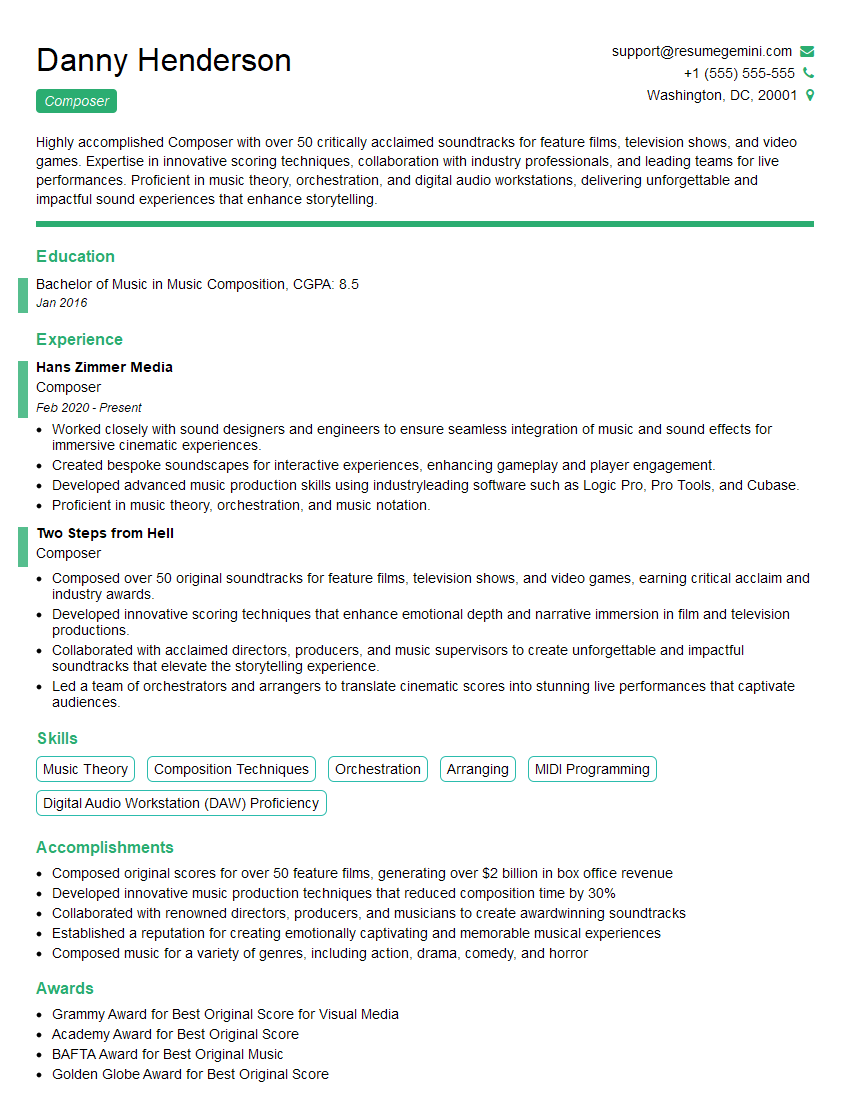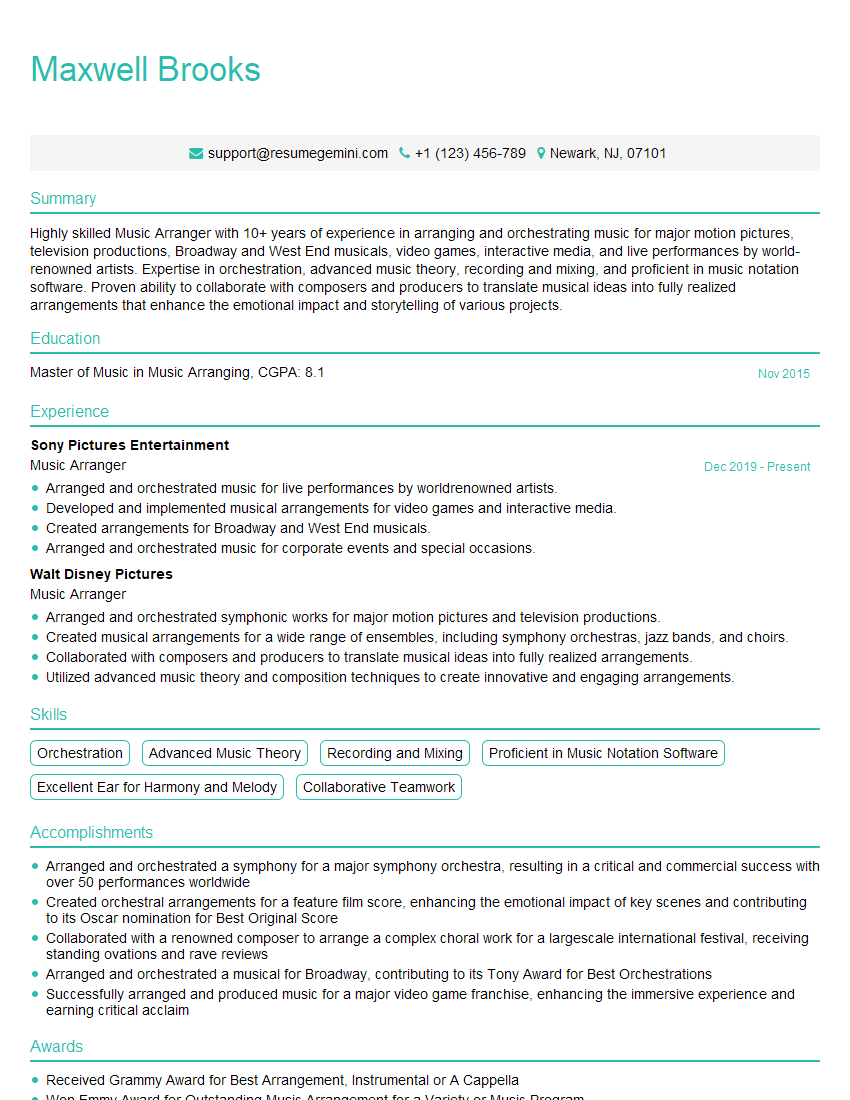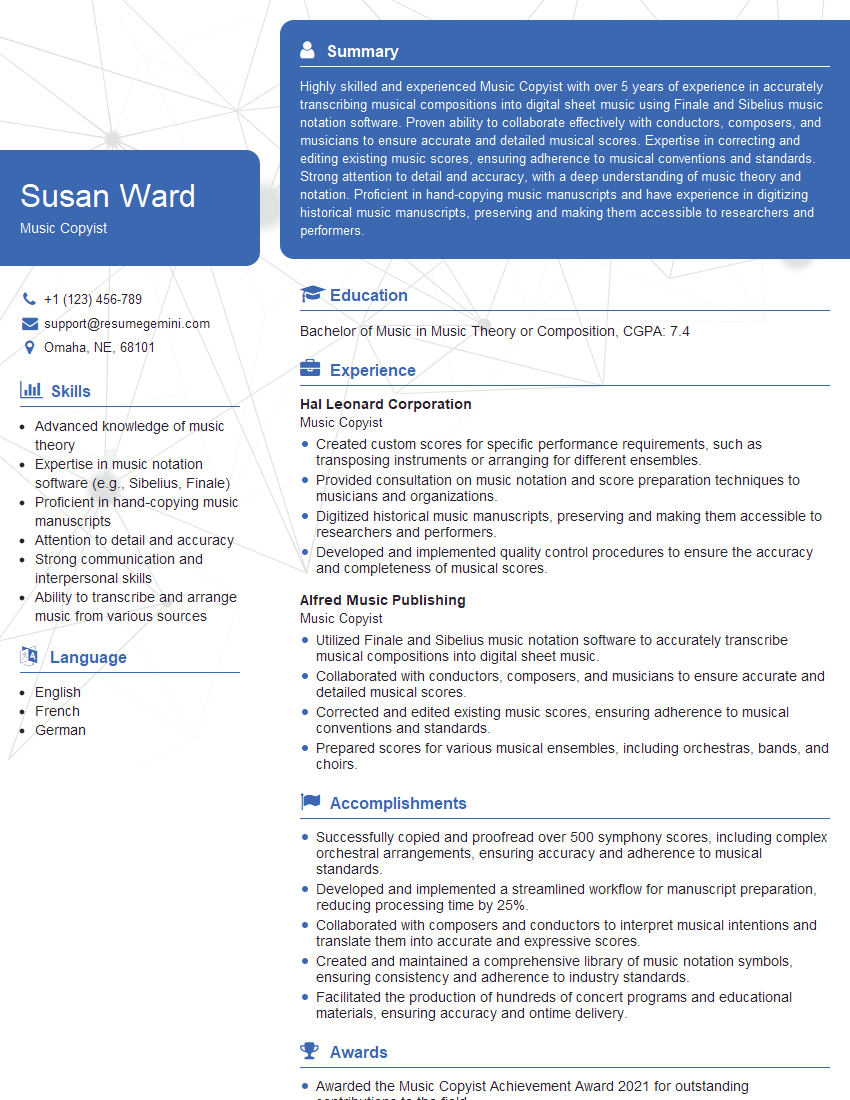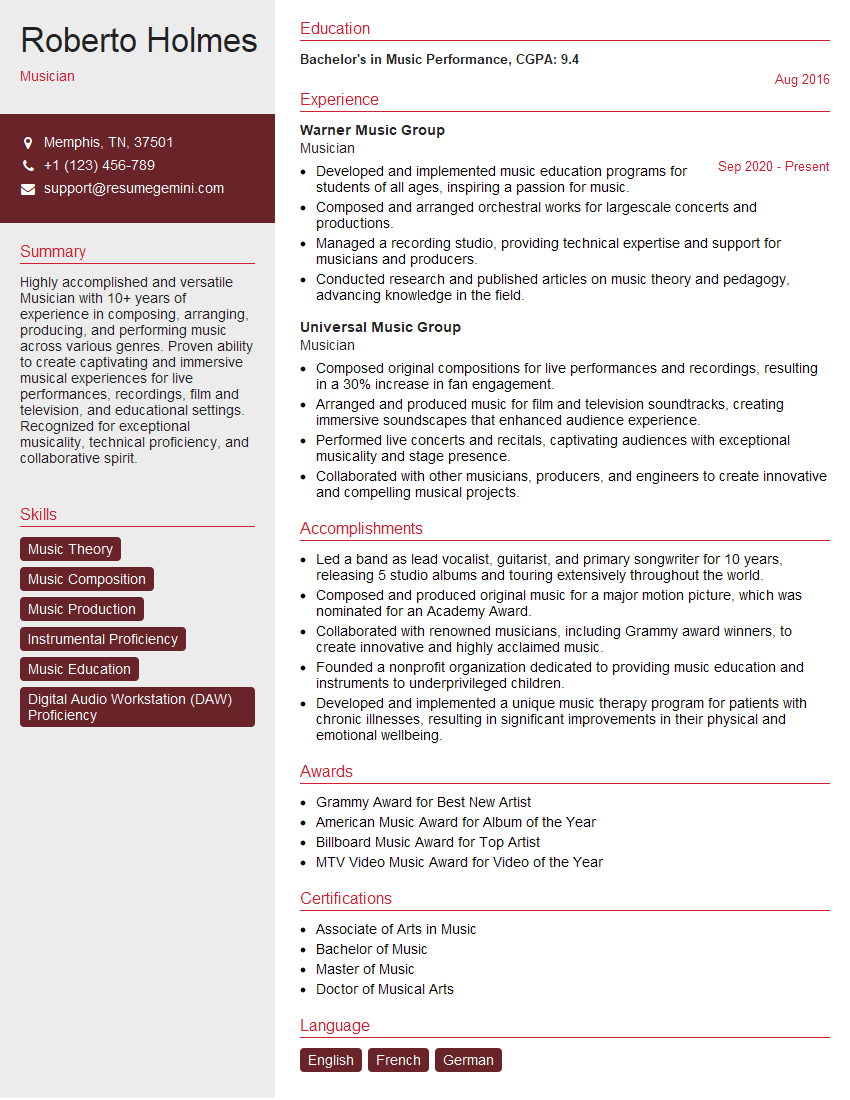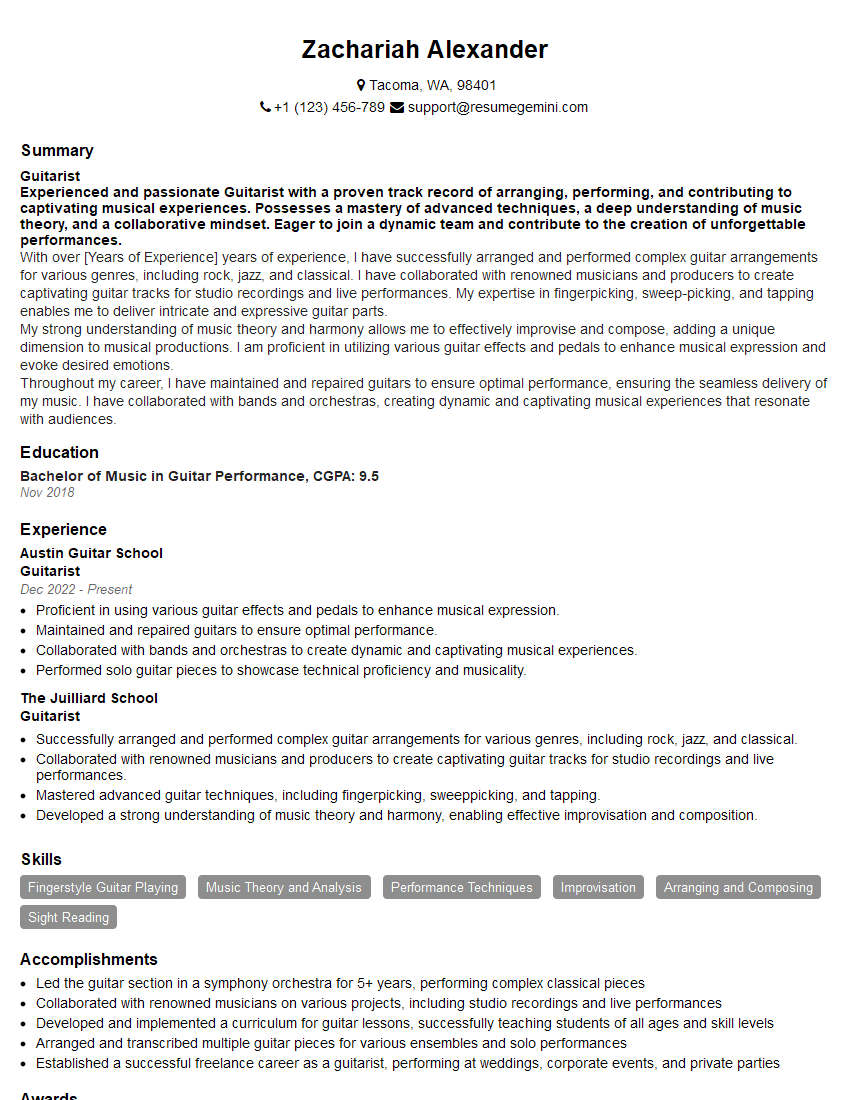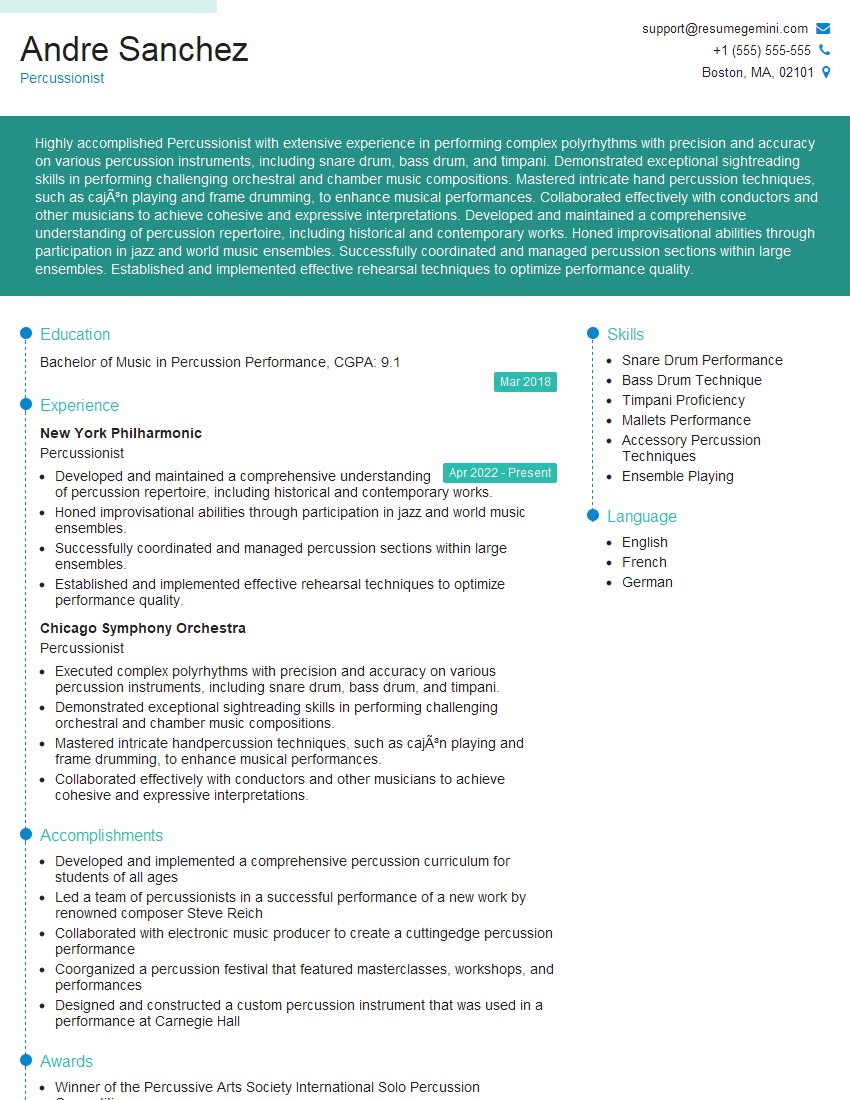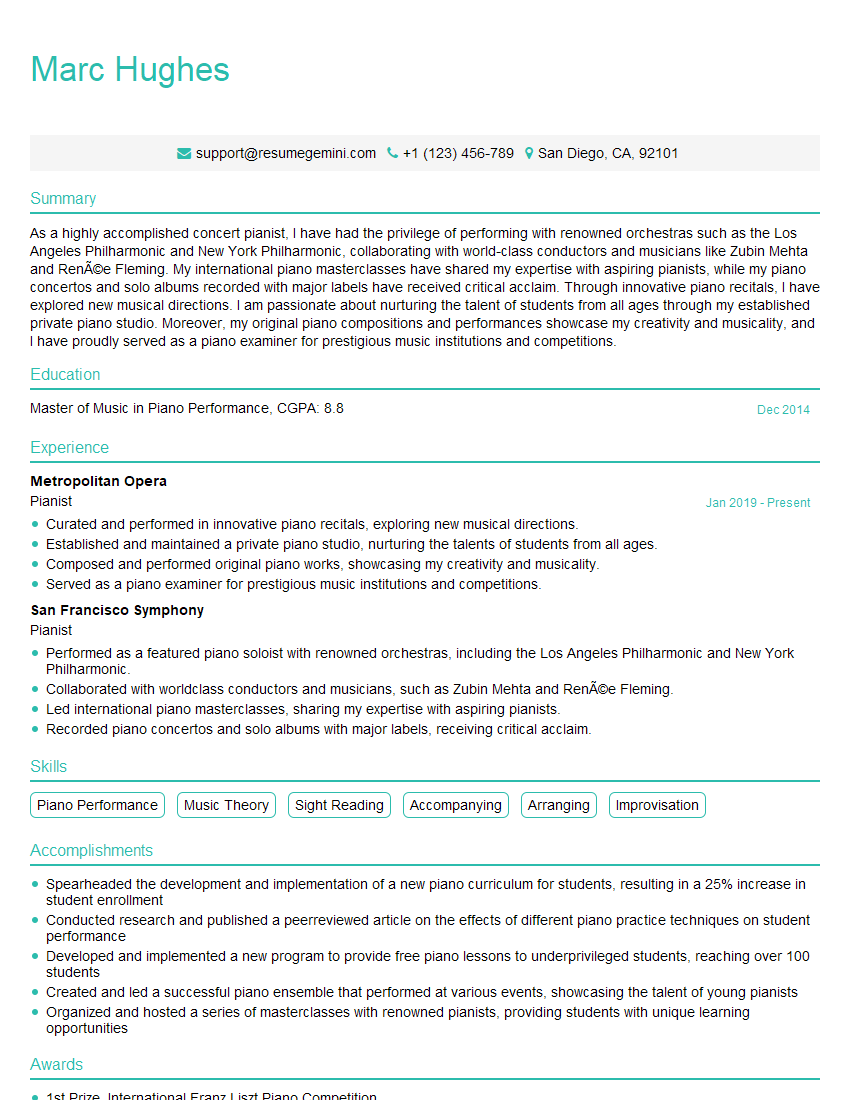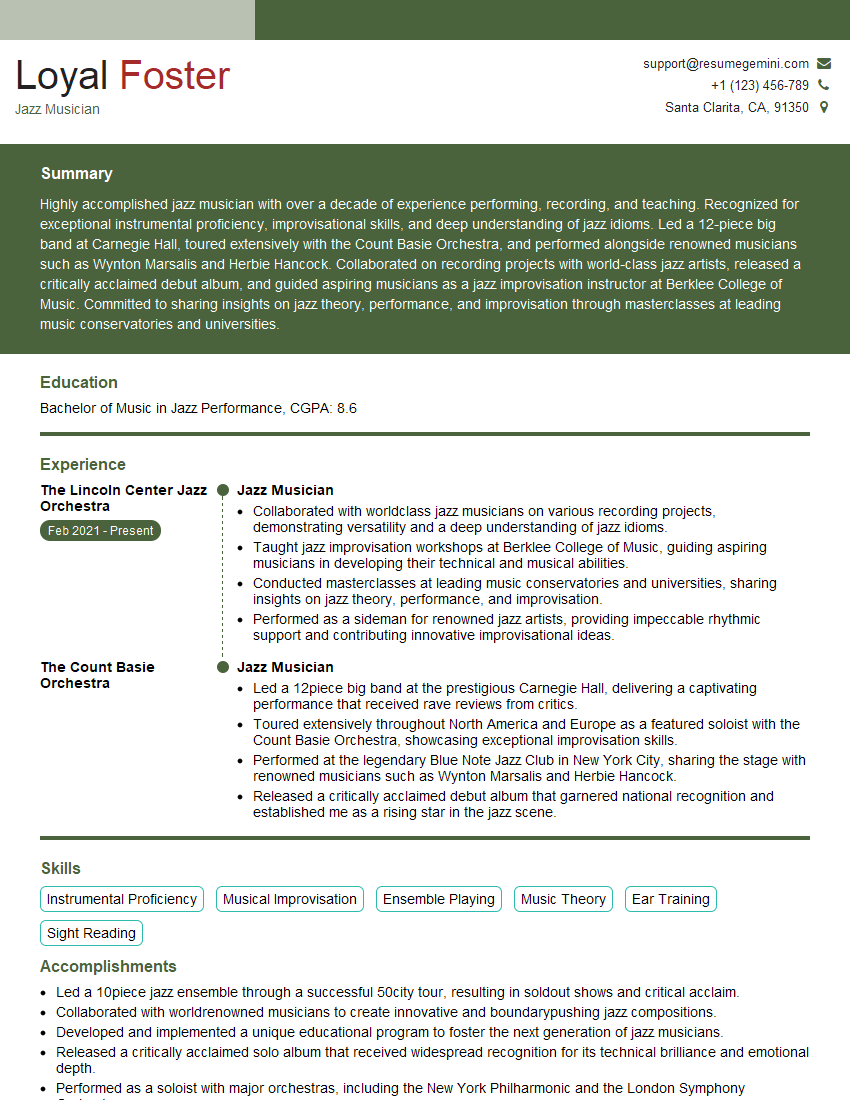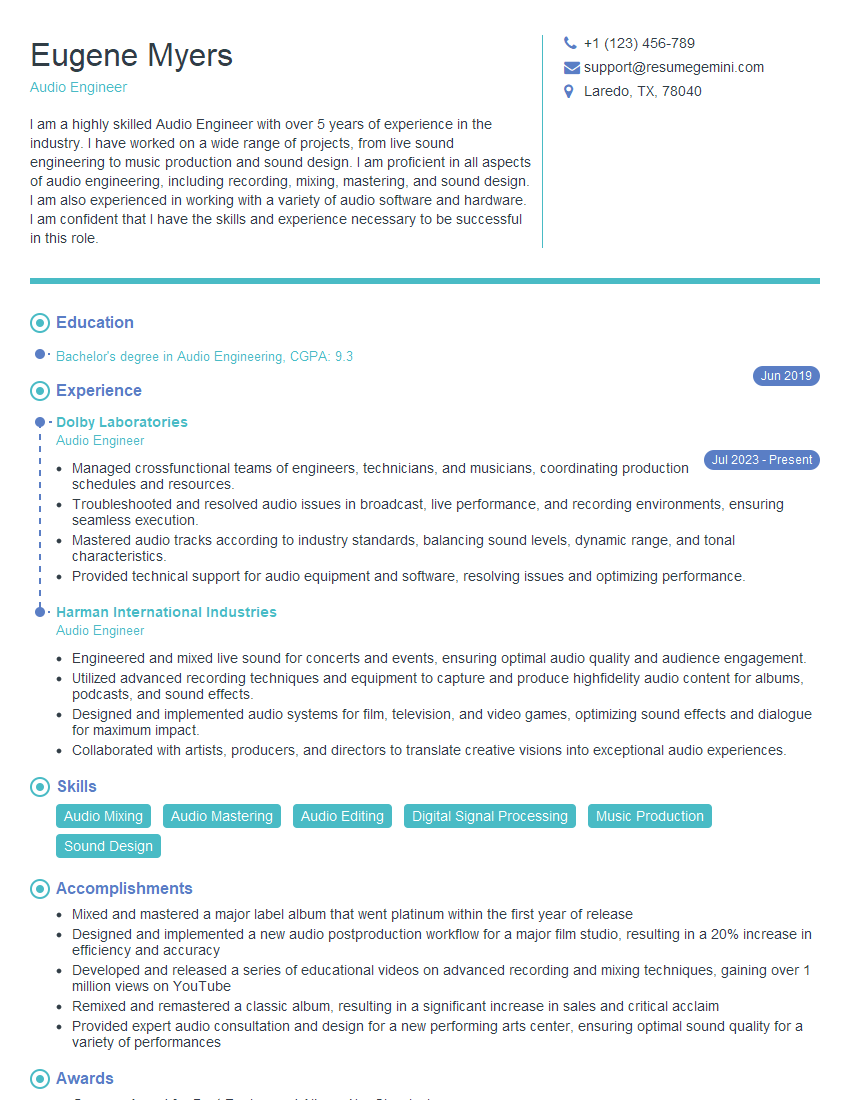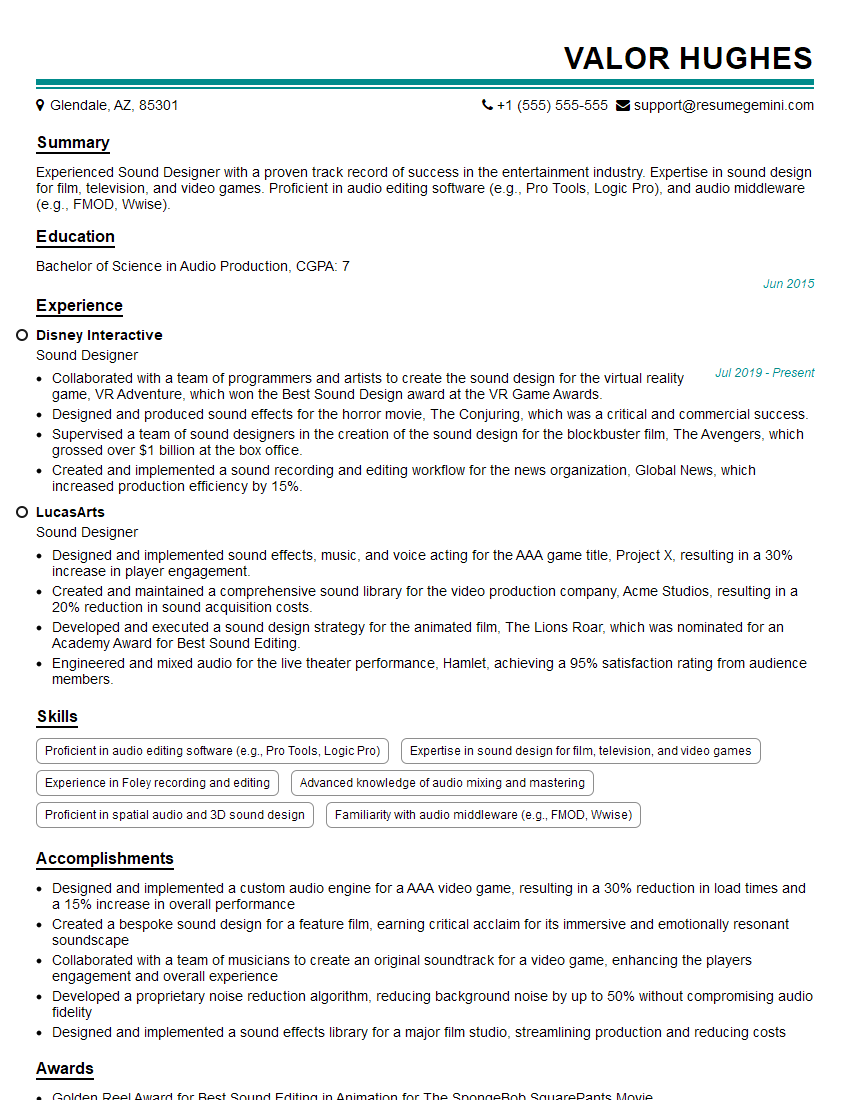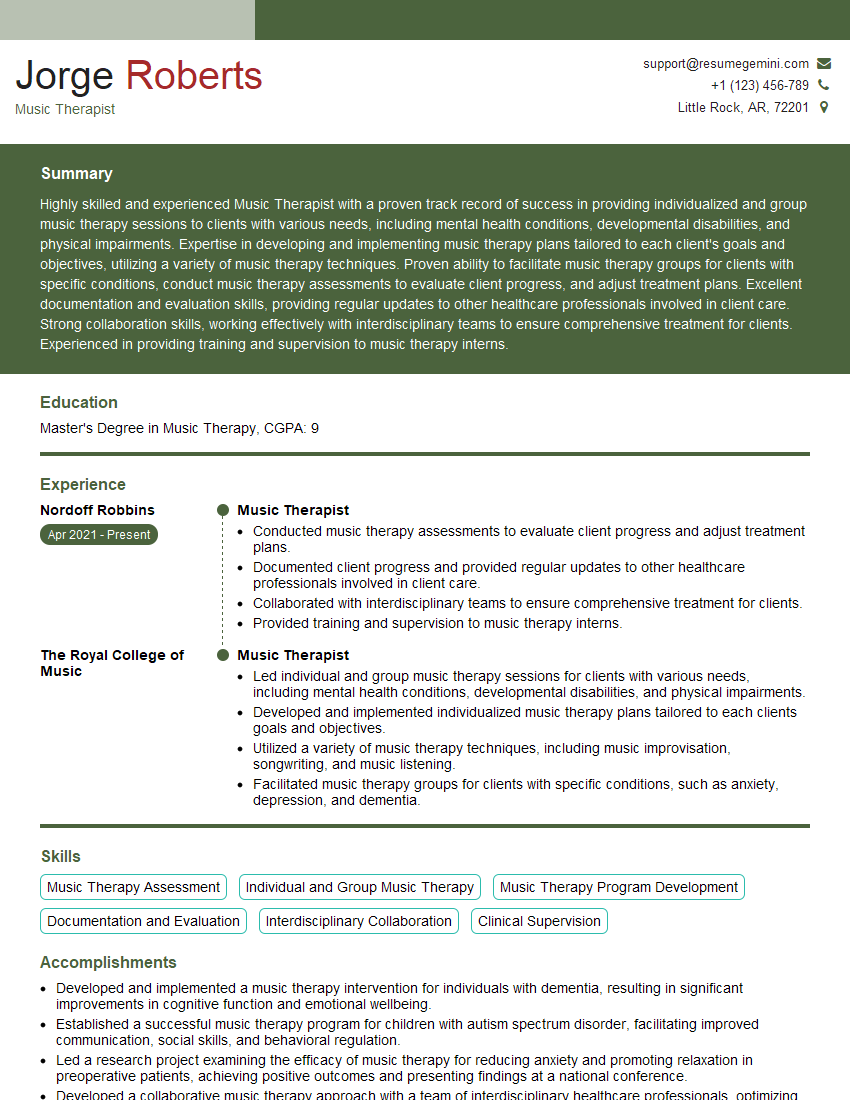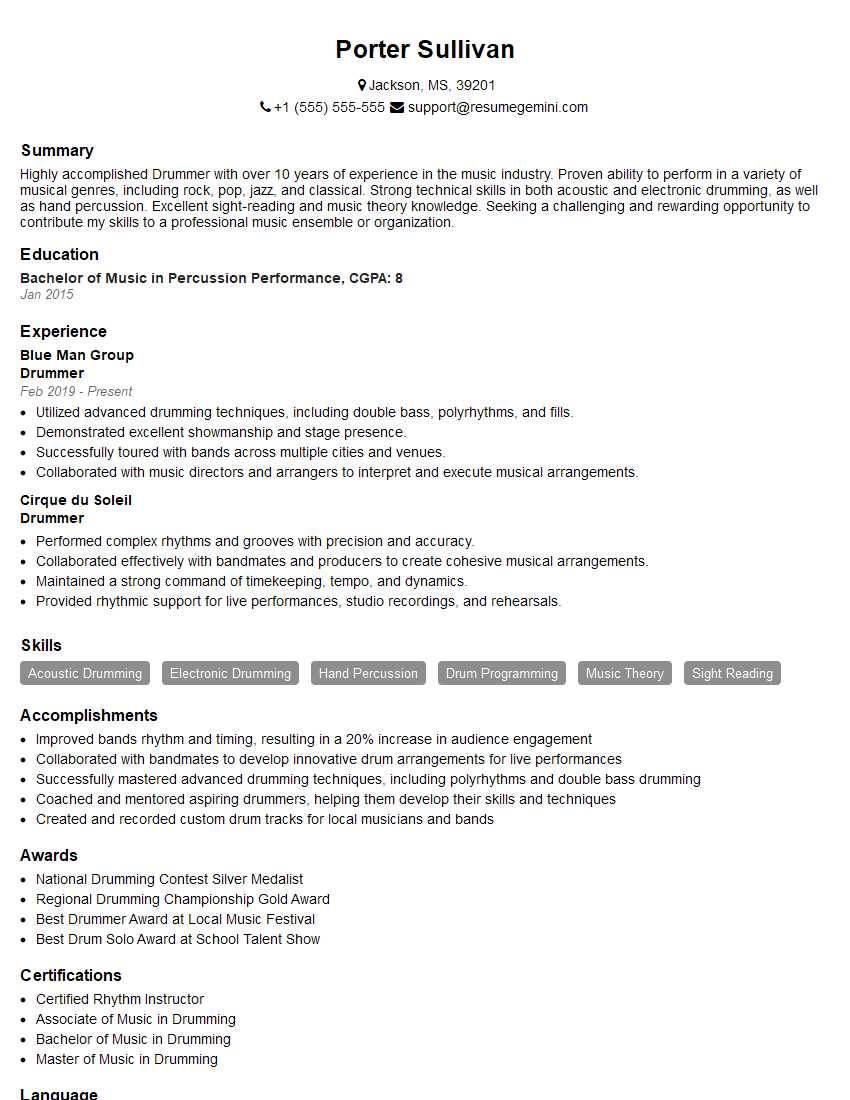Preparation is the key to success in any interview. In this post, we’ll explore crucial Music Performance and Improvisation Skills interview questions and equip you with strategies to craft impactful answers. Whether you’re a beginner or a pro, these tips will elevate your preparation.
Questions Asked in Music Performance and Improvisation Skills Interview
Q 1. Describe your approach to sight-reading unfamiliar music.
Sight-reading is the ability to perform music from a score without prior rehearsal. My approach involves a multi-stage process. First, I quickly scan the piece to grasp its overall structure – tempo, key, time signature, and general melodic contours. This gives me a ‘map’ of the musical landscape. Next, I focus on sections, tackling smaller phrases at a time. I pay close attention to rhythm and note values, meticulously following the notation. I then gradually increase the tempo, aiming for musicality rather than speed. Finally, I integrate the individual phrases into a coherent performance, paying attention to phrasing, dynamics, and articulation. Think of it like reading a novel – you don’t absorb the entire story at once; you read paragraph by paragraph, understanding the context before moving on. I often use a pencil to mark key points, like changes in harmony or tempo, further aiding my comprehension and execution.
For instance, encountering a complex passage with rapid arpeggios, I’ll break it down into smaller chunks, practicing each hand separately before combining them. This methodical approach ensures accuracy and fluidity.
Q 2. Explain your understanding of different improvisation techniques (e.g., pentatonic scales, blues scales).
Improvisation is the spontaneous creation of music. Several techniques enhance improvisational skills. Pentatonic scales, consisting of five notes, provide a simple yet expressive framework. They are naturally melodic and easy to navigate, making them excellent for beginners and experienced musicians alike. The blues scale, a variation of the pentatonic scale, adds a characteristic blue note (typically a flattened third or seventh), which adds a soulful, melancholic feel. Beyond scales, improvisation involves understanding chord progressions, using rhythmic variations, and incorporating melodic motifs. I employ various approaches depending on the context. Sometimes, I’ll start with a simple melodic idea and develop it by adding ornamentation, altering the rhythm, or modulating to a different key. Other times, I build improvisations based on rhythmic patterns, using a variety of articulations and dynamics to build intensity and interest.
For example, while playing blues, I might start with a pentatonic scale in the key of E, then add blues notes to create a more expressive and soulful phrase. I might then transition to a related key, say A, using a chromatic passing tone to smoothly connect the harmonies. This allows for rich harmonic movement and melodic surprise within the improvisational framework.
Q 3. How do you adapt your performance based on the audience and venue?
Adapting to the audience and venue is crucial for a successful performance. A formal concert in a large hall requires a different approach than an intimate jazz club gig. For instance, a large hall demands greater projection and control of dynamics to ensure audibility, while a smaller, intimate venue allows for more subtle nuances and closer interaction with the audience. I observe the audience’s energy and response. A lively audience might inspire more energetic performances, while a more reserved audience might call for a more subdued and introspective approach. The venue itself dictates technical aspects – microphone placement, lighting, and stage presence all affect the performance.
Imagine playing a lively piece in a quiet church setting versus a rowdy pub – the energy and volume need to be adjusted accordingly. In a formal setting, I might choose repertoire that showcases technical prowess, while in a relaxed environment, I’d focus on creating an engaging and interactive atmosphere.
Q 4. Describe your experience with ensemble playing and collaboration.
Ensemble playing is a cornerstone of my musical experience. Collaborative efforts require active listening, responsiveness, and a deep understanding of musical dynamics. Effective communication – both verbal and nonverbal – is paramount. I value clear articulation of musical intentions, ensuring everyone is on the same page regarding phrasing, dynamics, and tempo. A good ensemble relies on each member’s ability to support and complement others, creating a cohesive whole. My experience encompasses a wide range of ensembles, from small chamber groups to large orchestras, each presenting its unique challenges and rewards.
For example, while playing in a string quartet, I need to precisely match intonation with the other musicians, paying close attention to bowing techniques for a unified sound. In a big band, the ability to listen and react to the other sections becomes essential for creating a unified and powerful sound.
Q 5. How do you handle unexpected technical difficulties during a performance?
Unexpected technical difficulties are a reality in live performances. My approach involves preparedness, adaptability, and a calm demeanor. Before a performance, I meticulously check my instrument and equipment. During a performance, should a problem arise, I employ problem-solving skills. A broken string on a stringed instrument? I have a spare ready. A microphone malfunction? I adjust my projection and work with the sound engineer. The key is to remain calm and maintain composure. Panicking only exacerbates the situation. I strive to address the issue swiftly and efficiently, minimizing disruption to the performance. A good performer adapts, seamlessly transitioning from the unexpected event back into the flow of the music.
In one performance, a sudden power outage occurred. Instead of panicking, I quickly adapted. I continued the performance acoustically, engaging the audience with a different interpretation of the piece. This demonstrated adaptability and transformed a potential disaster into an engaging moment.
Q 6. Explain your process for composing or arranging music.
My composition and arrangement process is iterative. It begins with an initial idea, a melody, or a harmonic progression that sparks my imagination. I then develop this idea, exploring different variations and possibilities. I utilize musical software such as Sibelius or Finale to notate and refine my compositions. This allows me to experiment with orchestration and instrumentation, layering sounds to create textures and dynamics. The process often involves revision and refinement, constantly evaluating the piece’s structure, balance, and emotional impact. I continuously seek feedback from colleagues and mentors, integrating their insights to shape the final product.
For instance, if I start with a simple piano melody, I might arrange it for a string quartet, adding countermelodies and harmonies to expand upon the initial concept. I might also explore different instrumental voicings and rhythmic patterns to create a richer musical experience.
Q 7. Discuss your understanding of music theory and its application to improvisation.
Music theory forms the foundation of my improvisational skills. A solid understanding of harmony, melody, rhythm, and form provides a framework for creative expression. Knowing chord progressions allows me to construct coherent and interesting improvisations. Understanding scales and modes helps me choose appropriate notes within a given harmonic context. Furthermore, rhythmic variations and phrasing add expression and variety. Music theory acts as a guide but not a constraint; it allows me to make informed creative decisions, building improvisations that are both structurally sound and emotionally engaging.
For example, recognizing that a progression follows a II-V-I cadence in C major allows me to confidently choose notes from the dominant seventh chord (G7) before resolving to the tonic (C major). This theoretical understanding ensures harmonic coherence and provides a structure for creative melodic expression.
Q 8. How do you develop your musical creativity and inspiration?
Developing musical creativity and inspiration is a multifaceted process that involves nurturing both your innate talent and your conscious efforts. It’s like tending a garden – you need to plant seeds, water them regularly, and cultivate the environment for growth.
Active Listening: Immersing myself in diverse musical genres, from classical to jazz to world music, exposes me to new ideas and techniques. I actively listen, not just passively, paying attention to the nuances of composition, harmony, and phrasing.
Experimentation and Play: I dedicate time to spontaneous musical exploration. This might involve jamming on my instrument, experimenting with different sounds and textures, or composing short pieces without pre-conceived notions. It’s about letting the music flow freely.
Collaboration and Feedback: Working with other musicians is incredibly stimulating. Sharing ideas, receiving feedback, and experiencing different perspectives significantly boosts creativity. It’s like cross-pollination in a garden.
Seeking Inspiration from Other Arts: I find inspiration in other creative fields, such as visual art, literature, and even nature. The textures of a painting, the imagery in a poem, or the vastness of a landscape can all spark new musical ideas.
Mindfulness and Reflection: Taking time to clear my mind and reflect on my experiences and emotions often leads to unexpected creative breakthroughs. Journaling and meditation can facilitate this process.
Q 9. Describe your experience with different musical genres and styles.
My musical journey has encompassed a wide spectrum of genres and styles. I’ve spent years mastering classical piano, which instilled a deep appreciation for structure and technical precision. This foundation has proven invaluable in all my subsequent musical explorations.
Jazz Improvisation: Jazz improvisation has been a central focus, requiring me to develop skills in harmony, rhythm, and melodic invention. I’ve explored various jazz styles, from bebop to modal jazz, constantly seeking to expand my harmonic vocabulary and rhythmic sophistication.
World Music: I’ve delved into world music, learning about different scales, rhythms, and musical instruments from around the globe. This has enriched my compositional palette and broadened my understanding of musical diversity.
Contemporary Composition: My experience extends to contemporary classical music, where I experiment with extended techniques and unconventional approaches to composition and performance.
This diverse background allows me to blend different styles seamlessly and create a unique and versatile musical voice. It’s like having a rich palette of colors to choose from when painting a musical picture.
Q 10. How do you incorporate audience interaction into your improvisational performances?
Audience interaction is a vital aspect of improvisational performance. It transforms a one-way musical experience into a shared dialogue. My approach is to create a welcoming and responsive atmosphere where the audience feels comfortable participating.
Non-verbal cues: I watch the audience closely, paying attention to their reactions. Their energy and enthusiasm inform my choices.
Direct interaction: Sometimes, I might ask the audience for suggestions, such as a particular musical style or emotion. This can inspire surprising and exciting improvisations.
Call and response: I might incorporate simple call-and-response elements, inviting the audience to participate through clapping or singing along. It creates a sense of shared creativity.
Creating a playful atmosphere: Humor and lightheartedness can ease tension and invite audience participation. This doesn’t mean sacrificing musical integrity but rather finding ways to engage the audience in a relaxed and enjoyable way.
The key is to find a balance: maintaining artistic control while being receptive to audience energy and contributions. It’s a delicate dance between the performer and the audience, a collaborative creation.
Q 11. What are your strategies for memorizing and recalling complex musical pieces?
Memorizing and recalling complex musical pieces involves a combination of techniques. It’s not just about rote memorization, but rather building a deep understanding of the music’s structure and meaning.
Understanding the Structure: I begin by analyzing the piece’s form, identifying key sections, phrases, and harmonic changes. This structural understanding provides a roadmap for memorization.
Chunking: I break down the piece into smaller, manageable chunks, focusing on mastering each section before moving on. It’s like assembling a puzzle, one piece at a time.
Kinesthetic Learning: I use physical gestures and movements to associate with musical phrases or sections. This kinesthetic connection improves recall.
Mental Rehearsal: I regularly rehearse the piece mentally, visualizing myself playing it and hearing the music in my head. This mental practice strengthens memory pathways.
Recording and Playback: I record myself playing the piece and listen back repeatedly, identifying areas that need improvement and strengthening memory through repetition.
The process is iterative. I regularly revisit the piece, refining my understanding and memorization.
Q 12. How do you maintain your musical skills and knowledge?
Maintaining musical skills and knowledge is an ongoing commitment that requires consistent effort and dedication. It’s like maintaining a finely tuned instrument – regular maintenance is crucial.
Regular Practice: Daily practice is essential, even if it’s just for a short period. This ensures that my technical skills remain sharp and my musical memory stays fresh.
Continuing Education: I actively seek opportunities for professional development, such as attending masterclasses, workshops, and taking lessons from experienced musicians.
Exposure to New Music: I continually expand my musical horizons by listening to new recordings, attending concerts, and exploring diverse musical styles.
Collaboration: Playing with other musicians provides invaluable opportunities to learn and grow. The exchange of ideas and the challenge of adapting to different playing styles enhances musical development.
This multifaceted approach ensures that my musical skills and knowledge remain vibrant and relevant.
Q 13. Discuss your experience with using technology in music performance (e.g., digital audio workstations, notation software).
Technology has become an indispensable tool in music performance and composition. I use various technologies to enhance my creative process and performances.
Digital Audio Workstations (DAWs): I use DAWs such as Ableton Live and Logic Pro X for composing, recording, and mixing music. These tools allow for precise control over every aspect of the recording process. For example,
Ableton Live's session viewallows for highly flexible and improvisational composition.Notation Software: Software like Sibelius and Finale allows for precise notation of musical scores, facilitating both composition and analysis. The ability to edit and refine scores digitally is incredibly helpful.
MIDI Controllers and Synthesizers: I use MIDI controllers and synthesizers to create and manipulate sounds, extending my expressive capabilities beyond traditional acoustic instruments. I can build complex soundscapes with ease and explore textures that wouldn’t be possible without technology.
Technology doesn’t replace musical artistry but acts as a powerful tool to augment it. It allows for creativity and precision that were once unimaginable.
Q 14. Describe your approach to practicing and improving your improvisation skills.
Improving improvisation skills is a journey of continuous learning and refinement. My approach is structured yet flexible, allowing for both focused practice and spontaneous exploration.
Technical Foundation: A strong foundation in music theory, harmony, and rhythm is crucial. I regularly practice scales, chords, and rhythmic patterns to build fluidity and technical proficiency.
Ear Training: Developing a strong ear is essential for improvising effectively. I practice transcribing solos, identifying intervals, and recognizing chord progressions by ear.
Soloing Practice: I regularly practice improvising over different chord progressions and backing tracks, experimenting with different melodic ideas and rhythmic variations. I record myself to identify areas for improvement.
Transcribing and Analysis: I transcribe solos by master improvisers, analyzing their melodic, harmonic, and rhythmic choices. This provides valuable insights and inspiration.
Jamming and Collaboration: Jamming with other musicians is invaluable for developing improvisational skills. The interplay of ideas and the challenge of responding to other musicians in real time significantly enhances improvisational fluency.
Improvisation is a skill honed over time through dedicated practice and consistent exploration.
Q 15. Explain your understanding of musical phrasing and articulation.
Musical phrasing and articulation are fundamental elements that breathe life into a musical performance. Phrasing refers to the shaping of musical ideas into meaningful units, much like sentences in a written language. It involves controlling dynamics (loudness and softness), tempo (speed), and articulation (how individual notes are played or sung) to create expressive musical lines. Articulation, on the other hand, focuses on the precise execution of notes, defining their character and connection to each other.
Dynamics: Think of a crescendo (gradually getting louder) building the tension towards a climax, followed by a decrescendo (gradually getting softer) to create a sense of release. This dynamic phrasing shapes the emotional arc of a musical passage.
Tempo: A slight rubato (flexible tempo) can add expressiveness and emotional depth, while a strict tempo can create a feeling of precision and control. Consider the difference between a passionate, slightly hurried performance of a ballad versus a precisely measured, stately rendition.
Articulation: Articulation techniques such as legato (smooth, connected notes), staccato (short, detached notes), and accents (emphasized notes) contribute to the overall texture and character of the music. A legato melody feels smooth and flowing, while a staccato melody might sound playful or urgent.
For example, in a jazz solo, phrasing might involve creating a series of melodic ideas, each with its own dynamic and rhythmic contour, connected by subtle changes in tempo and articulation. A classical pianist might employ a precise and controlled articulation to bring out the intricacies of a Bach fugue.
Career Expert Tips:
- Ace those interviews! Prepare effectively by reviewing the Top 50 Most Common Interview Questions on ResumeGemini.
- Navigate your job search with confidence! Explore a wide range of Career Tips on ResumeGemini. Learn about common challenges and recommendations to overcome them.
- Craft the perfect resume! Master the Art of Resume Writing with ResumeGemini’s guide. Showcase your unique qualifications and achievements effectively.
- Don’t miss out on holiday savings! Build your dream resume with ResumeGemini’s ATS optimized templates.
Q 16. How do you maintain a consistent and engaging performance energy?
Maintaining consistent and engaging performance energy requires a multifaceted approach. It’s not just about being loud or energetic all the time; it’s about creating a compelling narrative through the music. This involves physical and mental preparation as well as intuitive understanding of the piece.
Physical Preparation: Adequate physical and vocal warm-ups are crucial for endurance. Practicing the piece until physical comfort and fluidity are established is also important. Good posture and mindful breathing support sustained energy.
Mental Preparation: Visualization and mindful meditation can help center the performer, reducing pre-performance anxiety. Understanding the emotional arc of the music and finding a personal connection to the piece can significantly enhance energy projection.
Interaction with Audience: Connecting with the audience through eye contact (when appropriate) and responding to their energy can create a powerful feedback loop that enhances energy levels throughout the performance. This doesn’t mean being overly theatrical, but rather genuine in the engagement.
Dynamic Control: Careful use of dynamics is critical. The ability to create contrasts between loud and soft passages, fast and slow sections keeps the audience engaged and prevents monotony. This contrast is what generates energy through the performance.
Imagine performing a concerto – the slower movements require a different kind of energy than the fast movements. Mastering the art of dynamic control is essential for maintaining a balanced and engaging energy level throughout the entire piece.
Q 17. Describe your experience working with other musicians in a collaborative setting.
Collaborative musical experiences are the heart of my artistic practice. I’ve worked extensively in various ensemble settings, including orchestras, chamber groups, and jazz combos. Effective collaboration requires strong communication, mutual respect, and a shared artistic vision.
Communication: Open and honest communication about musical ideas, interpretations, and technical challenges is paramount. I actively listen to my fellow musicians, offering constructive feedback and readily incorporating suggestions that enhance the overall performance.
Active Listening: In an improvisational setting, for instance, this includes reacting spontaneously to the musical ideas introduced by other musicians, creating a dynamic dialogue and keeping the energy flowing.
Shared Artistic Vision: Before a performance, I engage in discussions with fellow musicians to ensure a shared understanding of the musical style, interpretation, and overall approach. This shared vision leads to a more cohesive and powerful performance.
Compromise and Adaptability: I’m adept at adapting my playing style to suit the needs of the group and am willing to compromise to achieve a unified and effective musical result. This can mean adjusting my tone, rhythm, or melodic ideas to complement those of others.
For example, in a recent jazz gig, our group spontaneously extended a standard tune with an intricate improvisation. This was successful because of open communication and a willingness to listen to, and build off of, each other’s ideas.
Q 18. How do you troubleshoot technical issues during a live performance?
Troubleshooting technical issues during a live performance requires a proactive and calm approach. Preparation and quick thinking are key.
Preventative Measures: Before any performance, I meticulously check my equipment – instruments, microphones, cables, etc. – ensuring everything is functioning optimally. I also have backup equipment on hand, just in case.
Quick Problem Solving: If a problem arises, I try to assess the situation quickly and calmly, identifying the source of the issue. Is it a blown fuse? A loose cable? A malfunctioning instrument? I’ve learned how to quickly address many common issues.
Collaboration and Support: If the problem is beyond my expertise, I rely on the support of the sound engineer, stage manager, or fellow musicians. I clearly communicate the problem, allowing them to contribute to the solution.
Adaptation and Improvisation: If a problem is unavoidable, I’m skilled at improvising a solution, perhaps modifying a section of the music to accommodate the issue or employing alternative techniques to compensate for a malfunctioning instrument.
For instance, during one performance, my microphone suddenly cut out. I calmly switched to a backup microphone and continued without missing a beat, thanks to preparation and quick thinking. The audience didn’t notice.
Q 19. What are your strategies for overcoming performance anxiety?
Performance anxiety is a common experience for musicians. My strategies for overcoming it involve a combination of mental preparation, physical techniques, and experience.
Mental Preparation: Positive self-talk, visualization, and mindful meditation help manage anxiety. I focus on the positive aspects of the performance, the joy of sharing music, and the hard work invested in preparing the piece.
Physical Techniques: Deep breathing exercises and progressive muscle relaxation techniques can help calm the body’s physiological response to stress. Regular physical activity also contributes to reducing anxiety levels.
Experience and Practice: Experience performing in various settings greatly reduces anxiety. The more I perform, the more comfortable I become in handling unexpected situations and managing performance pressure. Thorough preparation ensures confidence in my abilities.
Focus on the Music: During the performance, I focus on the music itself, the interplay with other musicians, and the connection with the audience. This shifts my attention away from anxiety and onto the present moment.
I remember my first solo recital causing extreme anxiety. However, through consistent practice and performing in smaller settings, I developed the skills and confidence to manage these feelings.
Q 20. Explain your understanding of harmonic and rhythmic structures in music.
Harmonic and rhythmic structures are the foundational elements of music. Harmony refers to the simultaneous combination of sounds, creating chords and progressions. Rhythm refers to the organization of sound and silence in time.
Harmony: Understanding harmony involves knowing how chords are constructed (triads, seventh chords, etc.), how they function within a key (tonic, dominant, subdominant), and how they create progressions (sequences of chords). Different harmonic styles (e.g., major, minor, modal) create distinct moods and emotions.
Rhythm: Rhythm involves understanding basic rhythmic notation (whole notes, half notes, quarter notes, etc.), meter (the organization of beats into measures), and rhythmic complexities (syncopation, polyrhythms). The rhythmic structure gives music its pulse and drive.
Interaction: Harmony and rhythm are inextricably linked. The rhythmic structure can often define the harmonic progression, and vice-versa. A strong rhythmic pulse can create a framework for complex harmonic movement, while harmonic changes can influence rhythmic patterns.
For example, a simple I-IV-V-I chord progression in a major key (tonic, subdominant, dominant, tonic) creates a stable and satisfying harmonic framework, often underpinned by a steady, predictable rhythm. However, altering the rhythm (adding syncopation, for example) introduces a rhythmic complexity that affects the harmonic feel, potentially creating tension and release.
Q 21. How do you analyze and interpret musical scores effectively?
Effectively analyzing and interpreting musical scores involves a multi-step process encompassing several crucial aspects:
Understanding Notation: The first step involves a thorough understanding of musical notation: pitch, rhythm, dynamics, articulation, tempo markings, and key signatures.
Harmonic Analysis: Once the notation is understood, I analyze the harmonic structure of the piece. This includes identifying the key, chords, chord progressions, and any modulations (changes in key).
Rhythmic Analysis: I analyze the rhythmic structure, paying attention to the meter, rhythmic patterns, and any rhythmic complexities (syncopation, polyrhythms).
Formal Analysis: I analyze the form of the piece, identifying different sections (introduction, exposition, development, recapitulation, etc.) and how they relate to each other. This helps understand the overall structure and musical narrative.
Contextual Understanding: It is essential to consider the historical and stylistic context of the piece. Knowing the composer, the period in which the music was written, and the prevalent musical styles helps inform the interpretation.
Interpretation: Finally, I bring all this analysis together to create my own interpretation. This involves making artistic choices regarding tempo, dynamics, phrasing, and articulation to express the emotional content and musical meaning of the piece.
Consider analyzing a Beethoven sonata. The initial step would be decoding the notation, then analyzing the harmonic structure and rhythmic complexities within each movement. Further analysis of the sonata form and context within Beethoven’s oeuvre informs the performance approach.
Q 22. How do you integrate different musical styles and techniques in your improvisations?
Integrating diverse musical styles in improvisation is akin to being a culinary chef who blends unexpected yet complementary flavors. It’s about understanding the underlying harmonic and rhythmic structures of each style and finding common ground to create a cohesive whole. For example, I might start with a blues progression (a 12-bar blues structure is a great foundation), but then incorporate rhythmic elements from Afro-Cuban music – perhaps a clave rhythm – and melodic phrasing inspired by flamenco. This fusion isn’t arbitrary; it’s about recognizing shared musical elements, like the use of blue notes in both blues and flamenco, or the call-and-response patterns found in many cultures. I consciously choose elements that complement each other, creating tension and release through contrasting styles.
Technically, I might use a blues scale as a harmonic base, but then introduce chromaticism (notes outside the scale) to create unexpected harmonic movement. This can lead to a unique sound that combines the familiarity of the blues with the surprise of more complex harmonic language. The key is to have a strong theoretical understanding of diverse musical styles, and the ability to hear and feel how they can interact dynamically.
Q 23. Describe your experience teaching or mentoring other musicians.
My experience mentoring musicians has been incredibly rewarding. I’ve worked with students ranging from complete beginners to advanced players, and my approach is always personalized. I focus on building a strong foundation in music theory and ear training, emphasizing the importance of listening actively and developing a strong sense of rhythm. With beginners, I focus on building confidence and foundational skills like sight-reading and basic improvisation techniques, often through simple exercises and playing along with backing tracks. With more advanced students, we delve deeper into complex harmonic concepts, exploring different improvisation techniques like call and response, melodic contour, and rhythmic variations. I also encourage experimentation and self-discovery, guiding them to develop their unique musical voice. A recent success was helping a student develop her own original compositions, moving from simply mimicking styles to crafting her distinctive sound.
Q 24. What are your strengths and weaknesses as a musician and improviser?
My greatest strength as a musician and improviser lies in my ability to connect with an audience emotionally. I can tailor my performance to create a specific atmosphere, whether it’s intimate and reflective or energetic and exhilarating. I’m also adept at adapting my playing style to different contexts and collaborators. I always strive to build a strong harmonic foundation and create engaging melodic lines. However, one area I’m continually working on is broadening my technical proficiency on certain instruments. While I’m comfortable on several, I aim to improve my dexterity and speed on instruments I’m still developing. I’m also aware of a tendency to over-plan sometimes, which can stifle the spontaneity of improvisation. I’m actively working on embracing the unexpected and trusting my musical intuition more fully during improvisations.
Q 25. How do you balance creativity and technical proficiency in your performances?
Balancing creativity and technical proficiency is a delicate dance; it’s not a question of one being superior to the other. They are two sides of the same coin. Technical proficiency provides the foundation upon which creativity can flourish. Think of it like a painter – a strong understanding of color theory, brushstrokes, and composition provides the technical groundwork. However, the ability to create a unique and meaningful artwork comes from creative vision and expression. In my performances, I strive for a seamless integration of the two. I spend considerable time practicing and refining my technical skills, allowing me to effortlessly execute complex musical ideas. But this technical mastery is only a means to an end – the expression of a creative idea. Improvisation is the perfect arena for this balance – the technical skills enable me to execute the creative ideas that arise spontaneously, allowing freedom of expression within a structured framework.
Q 26. Explain your understanding of different musical forms and structures.
My understanding of musical forms and structures is comprehensive, encompassing various genres. I’m versed in traditional forms like sonata form (exposition, development, recapitulation), rondo form (ABACA), and theme and variations. I’m also knowledgeable about more contemporary structures, such as free improvisation where form is largely dictated by the interaction of the musicians. I understand how different forms affect the overall arc of a piece, the creation of tension and release, and the journey the listener experiences. For example, in a 12-bar blues, the predictable structure allows for creative exploration within those confines. In contrast, free improvisation relies on intuitive musical interaction, shaping the form organically.
Understanding these structures allows me to both adhere to them, creating a familiar and comfortable listening experience, and to break them, creating excitement and surprise. My ability to use these forms consciously and unconsciously is key to my compositional and improvisational abilities. It’s like knowing the rules of grammar before you can write a compelling story. You don’t need to always follow them strictly, but knowing them gives you the freedom to bend them or break them effectively.
Q 27. How do you adapt your performance style to different musical contexts?
Adapting my performance style to different contexts requires keen observation and responsiveness. In a small, intimate jazz club setting, my approach will differ significantly from a large festival performance. In a small club, the interaction with the audience is more direct, the dynamics are subtler, and the music might be more introspective. A festival performance might call for a more expansive, powerful sound to reach a larger audience. The same holds true for collaborating with different musicians. I adjust my approach based on the other players’ styles and strengths. If playing with a more aggressive rock band, my improvisations might incorporate more distortion and forceful rhythms. In contrast, playing with a classical ensemble would require a more restrained and nuanced approach. I listen carefully to my fellow musicians, always striving for a cohesive and mutually supportive musical exchange.
Q 28. Describe your experience in recording and producing music.
My experience in recording and producing music is extensive. I’ve worked in both professional studios and home studios, mastering various recording techniques. I’m proficient in using Digital Audio Workstations (DAWs) like Pro Tools and Logic Pro X. This involves everything from microphone placement and signal processing to mixing and mastering. My understanding encompasses the technical aspects, such as signal flow and equalization, as well as the creative aspects, like sound design and arrangement. I understand the importance of capturing a performance’s nuances and creating a polished final product. I’ve also had experience with various instruments and audio equipment, allowing me to approach recording from different angles – both technically and creatively. From recording acoustic performances to layering electronic sounds, I bring a versatility and attention to detail that ensure the final product accurately reflects the artistic vision.
Key Topics to Learn for Music Performance and Improvisation Skills Interview
- Musicality and Expression: Understanding phrasing, dynamics, articulation, and their role in conveying emotion and intent. Consider how different styles demand unique expressive techniques.
- Technical Proficiency: Demonstrating mastery of your instrument(s), including scales, arpeggios, chords, and rhythmic accuracy. Be prepared to discuss your practice techniques and how you maintain a high level of technical skill.
- Improvisation Techniques: Explore various approaches to improvisation, such as melodic improvisation, harmonic improvisation, rhythmic improvisation, and understanding different theoretical frameworks (e.g., modes, scales, chord progressions) that underpin improvisational choices.
- Aural Skills and Sight-Reading: Discuss your ability to quickly grasp new musical material, transcribe melodies, and sight-read accurately. Highlight how these skills contribute to both performance and improvisation.
- Ensemble Playing and Collaboration: Explain your experience working with others, including listening skills, responsiveness, and adapting to different musical styles and personalities within a group setting.
- Understanding Music Theory: Demonstrate a solid grasp of relevant theoretical concepts. Be ready to explain how theory informs your performance and improvisation choices, not just as a theoretical exercise, but as a practical tool.
- Style and Genre Expertise: Showcase your proficiency in specific musical genres and styles. Explain how your approach to performance and improvisation differs across various genres.
- Problem-Solving in Performance: Discuss how you handle unexpected situations during a performance or improvisation, such as technical difficulties or unexpected musical turns from collaborators. Highlight your adaptability and resourcefulness.
Next Steps
Mastering Music Performance and Improvisation Skills is crucial for career advancement in the dynamic world of music. Whether you are aiming for orchestral work, solo performance, teaching, or composing, these skills are fundamental to success. To significantly enhance your job prospects, creating a strong, ATS-friendly resume is essential. ResumeGemini is a trusted resource that can help you craft a professional and impactful resume tailored to highlight your unique skills and experiences. Examples of resumes specifically tailored for Music Performance and Improvisation Skills are available to guide you.
Explore more articles
Users Rating of Our Blogs
Share Your Experience
We value your feedback! Please rate our content and share your thoughts (optional).
What Readers Say About Our Blog
Hello,
We found issues with your domain’s email setup that may be sending your messages to spam or blocking them completely. InboxShield Mini shows you how to fix it in minutes — no tech skills required.
Scan your domain now for details: https://inboxshield-mini.com/
— Adam @ InboxShield Mini
Reply STOP to unsubscribe
Hi, are you owner of interviewgemini.com? What if I told you I could help you find extra time in your schedule, reconnect with leads you didn’t even realize you missed, and bring in more “I want to work with you” conversations, without increasing your ad spend or hiring a full-time employee?
All with a flexible, budget-friendly service that could easily pay for itself. Sounds good?
Would it be nice to jump on a quick 10-minute call so I can show you exactly how we make this work?
Best,
Hapei
Marketing Director
Hey, I know you’re the owner of interviewgemini.com. I’ll be quick.
Fundraising for your business is tough and time-consuming. We make it easier by guaranteeing two private investor meetings each month, for six months. No demos, no pitch events – just direct introductions to active investors matched to your startup.
If youR17;re raising, this could help you build real momentum. Want me to send more info?
Hi, I represent an SEO company that specialises in getting you AI citations and higher rankings on Google. I’d like to offer you a 100% free SEO audit for your website. Would you be interested?
Hi, I represent an SEO company that specialises in getting you AI citations and higher rankings on Google. I’d like to offer you a 100% free SEO audit for your website. Would you be interested?
good
